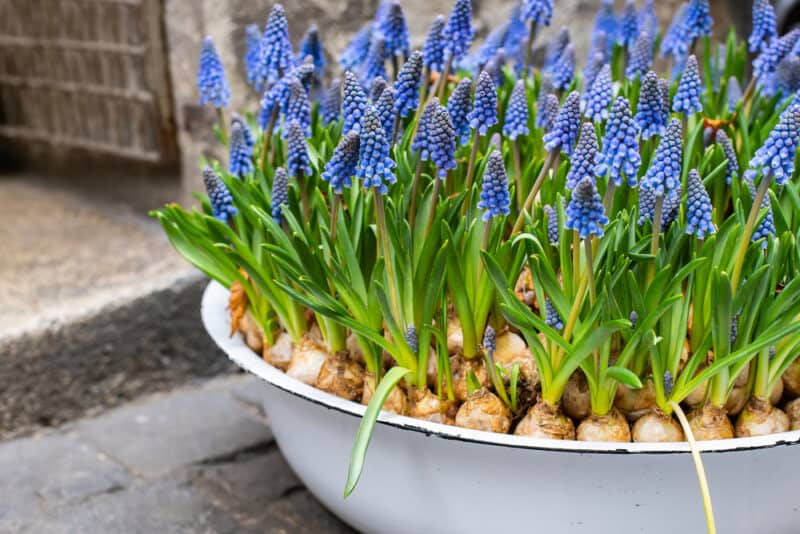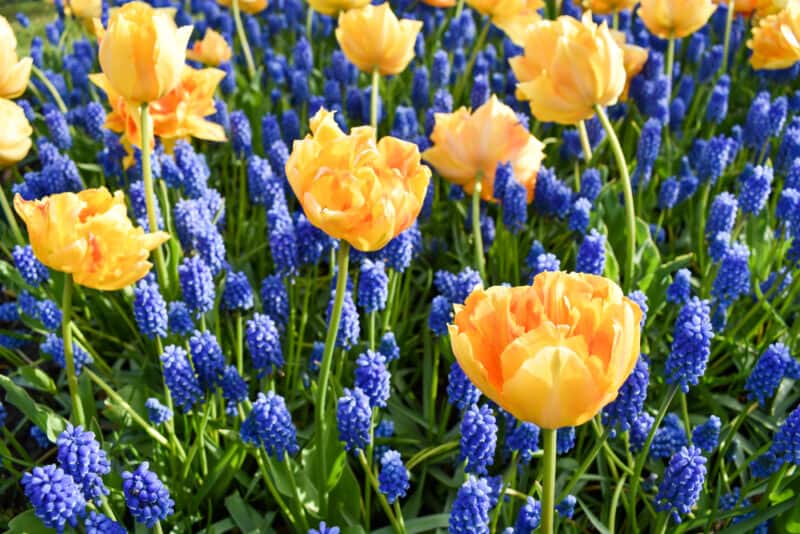Although this little plant has a short blooming period, grape hyacinth makes a big impact in the garden. Available in multiple colors, it creates texture and color that stands out from other plants in the garden.
They’re perfect for mass planting in an area where you don’t mind them spreading, and they also look great in containers where they will happily add color to decks and outdoor seating areas.
Armenian Grape Hyacinth, scientifically known as Muscari Armeniacum, produces stunning bell-shaped flowers in shades of blue, purple, and white These flowers grow in clusters resembling grapes, giving rise to their common name While the blooms add vibrance and beauty to any garden, properly harvesting them at the right time using the proper techniques ensures you obtain the highest quality flowers that last. In this article, we will explore optimal timing and step-by-step techniques for harvesting Armenian Grape Hyacinth flowers.
Determining the Best Time to Harvest
Timing is everything when it comes to harvesting Armenian Grape Hyacinth blooms Pick them too soon, and you’ll have closed buds that don’t open. Harvest too late, and they may already be wilting The key is to cut the flowers when they are in full bloom for peak freshness and visual appeal.
In most climates, Armenian Grape Hyacinth enters its flowering stage in mid to late spring. Depending on your local conditions, this is generally from mid-April through May. The exact timing varies depending on factors like weather and soil conditions. Your best bet is to regularly monitor the plants, looking for the following signs that indicate the flowers are ready for harvesting:
- Flower clusters appear full and rounded as the buds open.
- Bud color is fully developed, with rich, vivid pigment.
- Squeezed buds feel firm.
- No signs of wilting are present.
Once most buds on a stalk are open but before any evidence of fading, it’s go time! Use these visual cues to determine the optimal moment for harvesting.
Step-By-Step Harvesting Techniques
With timing figured out, let’s discuss the best practices for cutting and handling Armenian Grape Hyacinth blooms to maintain quality from garden to vase. Follow these steps for success:
1. Use Sharp, Clean Cutting Tools
The first step is gathering sharp, sterilized pruning shears, scissors, or a knife. Sharp blades make clean cuts, preventing crushing or bruising. Clean tools reduce the chance of spreading disease. Remove any dirt or debris and wipe with rubbing alcohol.
2. Cut Stems at a 45 Degree Angle
When making your cut, use a 45 degree angle rather than cutting straight across. Angled cuts allow for better water intake, keeping cut flowers hydrated and fresh longer.
3. Select Healthy, Unblemished Stems
Inspect plants and choose stems with no signs of damage, spots, wilting, or discoloration. Pick stems with healthy foliage and buds. Avoid any that look dry, brittle, or browned.
4. Cut Stems Above a Leaf Node
Locate a leaf node – the point where a leaf branchs off the stem. Make your cut just above a node. Leaving foliage preserves the plant’s ability to photosynthesize.
5. Remove Lower Leaves
After cutting the stem above a leaf node, strip off any foliage that would fall below the water line in your vase. Submerged leaves rot, decreasing vase life.
6. Place Stems in Water Right Away
As soon as each stem is cut, place it in a bucket of fresh water. This prevents air embolisms that block water flow through the stems.
7. Re-Cut Stems
Once your bouquet is complete, use a sharp knife to trim 1-2 inches off the bottom of the stems. This opens up fresh pathways for water absorption.
8. Use Floral Preservative
Consider adding floral preservative to the water to supply nutrients, combat bacteria, and maximize bloom longevity.
Follow these steps for the prettiest, longest-lasting Armenian Grape Hyacinth blooms. Monitor their vase life and refresh water as needed. With proper technique, you can enjoy their unique beauty for over a week!
Enjoying the Harvest
Now that you’ve expertly harvested your Armenian Grape Hyacinth blossoms, it’s time to enjoy them! Here are some ideas:
-
Create colorful arrangements in vases, jars, and bottles.
-
Craft gorgeous bouquets for gifts, centerpieces, or home decor.
-
Infuse vinegars, sugars, oils, or liquors with the edible flowers.
-
Float blooms in bowls of fruit or salad for a pop of color.
-
Dry the flowers to preserve them for wreaths, potpourri, or pressing.
-
Mix the blooms into resin or wax to make art, candles, or jewelry.
With the right timing and careful technique, you can fill your home with the beauty, fragrance, and uniqueness of Armenian Grape Hyacinth flowers. Follow these guidelines for a successful harvest and let your creativity guide you in using these special blooms.

How to Care for Grape Hyacinth
Choose a site in full sun because this is where grape hyacinth does best. Partial shade is okay, as well, but you might not get the same growth and color that you would otherwise. Some species are more tolerant of poor light than others.
Soil type isn’t a problem as long as it’s not waterlogged or soggy. Make sure the soil drains well, and don’t worry about pH.
Planted in the appropriate Zone, grape hyacinths are reliable year after year. Like many spring bulbs, they do need a cold winter period, called vernalization, to bloom the following spring. If you have a warmer-than-usual winter, this may cause some bloom failure.
You generally don’t need to fertilize grape hyacinth. Sprinkle the soil with bone meal when you first plant. If they look like they are struggling, sprinkle more bone meal and water it in well.

As the bulbs and plant are small, grape hyacinth suit containers well. Plant the bulbs in fall three to four inches deep. Choose a container that allows for spacing of about three to four inches apart.
The container must be well-draining as the bulbs will rot if left in a growing medium that is soaking.
Keep the container in a warm and sunny to partially sunny area. In early spring, move them to a sunny position and don’t allow the soil to dry out for too long, but don’t water until the top inch of the soil is dry.
Companion Planting for Grape Hyacinth

In gardens or borders, plant with:
When planting under trees and shrubs for mass color, choose early-blooming ones like:
What to do with grape hyacinths after flowering?
FAQ
How do you harvest hyacinth flowers?
What is the bloom time for grape hyacinth?
What do I do with grape hyacinths after flowering?
How do you preserve grape hyacinth flowers?
Is Muscari armeniacum a grape hyacinth?
For a hit of intense blue in the garden in mid-spring, Muscari armeniacum can’t be beat. This small perennial bulb produces clusters of bell-shaped flowers that resemble bunches of grapes, giving rise to the common name grape hyacinth.
What is a grape hyacinth?
Grape hyacinth ( Muscari armeniacum) is a mid-spring blooming, perennial bulb in the Lily Family (Liliaceae) native to southeastern Europe. It is not a true hyacinth (genus Hyacinthus ). The name of the genus, Muscari, comes from the Greek word for musk, referring to the scent produced by the flowers of many species in the genus.
How do you grow grape hyacinth?
Grow grape hyacinth in well-drained soil in sun to shade. Place in full sun for maximum vigor. However, the flowers last longer in partial shade. Plant the bulbs in the fall, placing bulbs 3 to 4 inches deep and 2 inches apart. The plants benefit from bone meal applied at planting and after blooming.
How many florets does a grape hyacinth have?
Grape hyacinth produces 1-3 flower stalks per bulb (L), with 20-40 tightly packed florets (LC). Each bell-shaped floret has a white band on the rim (C). The flowers open from the bottom up the inflorescence (RC) and if pollinated are followed by tripartite seed pods (R). Grape hyacinth combines well with other spring bulbs and low perennials.
